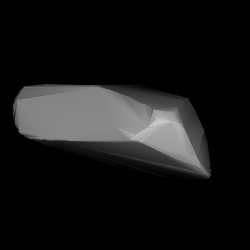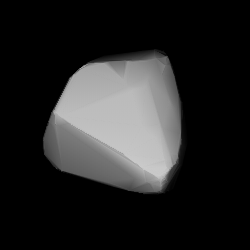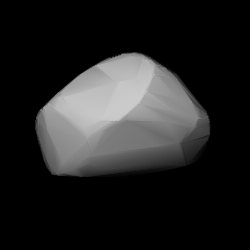Related Research Articles
Athalia, provisional designation 1903 ME, is a carbonaceous Themistian asteroid from the outer regions of the asteroid belt, approximately 40 kilometers in diameter. It was discovered on 20 September 1903, by German astronomer Max Wolf at the Heidelberg Observatory in southwest Germany. The asteroid was named after the ancient Judahite queen Athaliah.
656 Beagle, provisional designation 1908 BU, is an asteroid from the outer regions of the asteroid belt, approximately 60 kilometers in diameter. It was discovered on 22 January 1908, by German astronomer August Kopff at the Heidelberg Observatory. It is the principal body and namesake of the small Beagle cluster located within the Themis family. The C-type asteroid is likely highly elongated and has a rotation period of 7.0 hours. It was named for Charles Darwin's ship, HMS Beagle.
848 Inna is a carbonaceous Themistian asteroid from the outer regions of the asteroid belt. It was discovered on 5 September 1915, by astronomer Grigory Neujmin at the Simeiz Observatory on the Crimean peninsula. The C-type asteroid measures approximately 33 kilometers in diameter, while its rotation period remains unknown. It was named after Russian astronomer Inna Nikolaevna Leman-Balanovskaya (1881–1945).
1168 Brandia, provisional designation 1930 QA, is a stony Eunomian asteroid from the central regions of the asteroid belt, approximately 10 kilometers in diameter. Discovered by astronomer Eugène Delporte at Uccle Observatory in 1930, the asteroid was later named after mathematician Eugène Brand.
1581 Abanderada, provisional designation 1950 LA1, is a dark Themistian asteroid from the outer regions of the asteroid belt, approximately 35 kilometers in diameter. It was discovered on 15 June 1950, by Argentine astronomer Miguel Itzigsohn at the La Plata Astronomical Observatory in La Plata, Argentina. The asteroid was named after Eva Perón.

1286 Banachiewicza is an elongated Eos asteroid from the outer regions of the asteroid belt. It was discovered on 25 August 1933, by Belgian astronomer Sylvain Arend at the Royal Observatory of Belgium in Uccle. The stony S-type asteroid has a rotation period of 8.6 hours and measures approximately 21 kilometers in diameter. It was named after Polish astronomer Tadeusz Banachiewicz.
1707 Chantal, provisional designation 1932 RL, is a stony background asteroid from the Florian region in the inner asteroid belt, approximately 7.5 kilometers in diameter. It was discovered on 8 September 1932, by astronomer Eugène Delporte at the Royal Observatory of Belgium in Uccle. The S-type asteroid has a rotation period of at least 10 hours. It was named for Chantal, the niece of Belgian astronomer Georges Roland.

1576 Fabiola, provisional designation 1948 SA, is a Themistian asteroid from the outer regions of the asteroid belt, approximately 27 kilometers in diameter. It was discovered on 30 September 1948, by Belgian astronomer Sylvain Arend at the Royal Observatory of Belgium in Uccle. The asteroid was named after Queen Fabiola of Belgium.
1253 Frisia, provisional designation 1931 TV1, is a carbonaceous Themistian asteroid from the outer regions of the asteroid belt, approximately 20 kilometers in diameter. Discovered by Karl Reinmuth at Heidelberg Observatory in 1931, the asteroid was later named after the region of Frisia and the Frisian Islands.
1199 Geldonia, provisional designation 1931 RF, is an Eoan asteroid from the outer regions of the asteroid belt, approximately 32 kilometers in diameter. It was discovered on 14 September 1931, by Belgian astronomer Eugène Delporte at the Royal Observatory of Belgium in Uccle. The asteroid was named after the Belgian town of Jodoigne.
1261 Legia, provisional designation 1933 FB, is a dark Themistian asteroid from the outer regions of the asteroid belt, approximately 32 kilometers in diameter. It was discovered on 23 March 1933, by astronomer Eugène Delporte at the Royal Observatory of Belgium in Uccle. The asteroid was named for the Belgian city of Liège (Luke).

1361 Leuschneria, provisional designation 1935 QA, is a carbonaceous asteroid from the outer regions of the asteroid belt, approximately 30 kilometers in diameter. It was discovered on 30 August 1935, by Belgian astronomer Eugène Delporte at Uccle Observatory in Belgium, and named after American astronomer Armin Otto Leuschner.
1755 Lorbach, provisional designation 1936 VD, is a stony Eoan asteroid from the outer region of the asteroid belt, approximately 25 kilometers in diameter.
1287 Lorcia, provisional designation 1933 QL, is an Eoan asteroid from the outer regions of the asteroid belt, approximately 22 kilometers in diameter. It was discovered by Belgian astronomer Sylvain Arend at the Royal Observatory of Belgium in Uccle on 25 August 1933. The asteroid was named for Laura de Sołohub Dikyj, wife of Polish astronomer Tadeusz Banachiewicz.
1238 Predappia, provisional designation 1932 CA, is a dark Adeonian asteroid from the central regions of the asteroid belt, approximately 21 kilometers in diameter. It was discovered on 4 February 1932, by astronomer Luigi Volta at the Observatory of Turin in Pino Torinese, Italy. It was later named after the Italian village of Predappio.
1426 Riviera, provisional designation 1937 GF, is a bright asteroid from the central regions of the asteroid belt, approximately 16 kilometers in diameter. Discovered by Marguerite Laugier at the Nice Observatory in 1937, the asteroid was later named for the Côte d'Azur, also known as French Riviera.

1249 Rutherfordia, provisional designation 1932 VB, is an elongated, stony Florian asteroid from the inner regions of the asteroid belt, approximately 13 kilometers in diameter. Discovered by Karl Reinmuth at Heidelberg Observatory in 1932, the asteroid was named after Rutherford, New Jersey a suburb of New York City, United States.

2384 Schulhof (prov. designation: 1943 EC1) is a mid-sized asteroid and the namesake of the Schulhof family, located in the Eunomian region of the intermediate asteroid belt. It was discovered on 2 March 1943, by French astronomer Marguerite Laugier at Nice Observatory in southeastern France. The asteroid was later named after Hungarian astronomer Lipót Schulhof. The presumed S-type asteroid has a short rotation period of 3.3 hours and measures approximately 12 kilometers (7.5 miles) in diameter.

1276 Ucclia is a carbonaceous Alauda asteroid from the outer region of the asteroid belt, approximately 31 kilometers in diameter. It was discovered on 24 January 1933 by Belgian astronomer Eugène Delporte at the Royal Observatory of Belgium in Uccle. Two nights later, the body was independently discovered by Richard Schorr at Bergedorf Observatory in Hamburg, Germany. It was named for the Belgium city of Uccle and its discovering observatory.
1302 Werra, provisional designation 1924 SV, is a Themistian asteroid from the outer regions of the asteroid belt, approximately 30 kilometers in diameter. It was discovered on 28 September 1924, by German astronomer Karl Reinmuth at the Heidelberg-Königstuhl State Observatory. The asteroid was named for the river Werra in central Germany.
References
- 1 2 3 4 5 6 7 8 9 "JPL Small-Body Database Browser: 1247 Memoria (1932 QA)" (2017-12-02 last obs.). Jet Propulsion Laboratory. Archived from the original on 18 September 2020. Retrieved 3 January 2018.
- ↑ "memoria technica" . Oxford English Dictionary (Online ed.). Oxford University Press.(Subscription or participating institution membership required.)
- 1 2 3 Schmadel, Lutz D. (2006). "(1247) Memoria". Dictionary of Minor Planet Names. Springer Berlin Heidelberg. p. 103. doi:10.1007/978-3-540-29925-7_1248. ISBN 978-3-540-00238-3.
- 1 2 "Asteroid 1247 Memoria – Nesvorny HCM Asteroid Families V3.0". Small Bodies Data Ferret. Retrieved 26 October 2019.
- 1 2 Tedesco, E. F.; Noah, P. V.; Noah, M.; Price, S. D. (October 2004). "IRAS Minor Planet Survey V6.0". NASA Planetary Data System. 12: IRAS-A-FPA-3-RDR-IMPS-V6.0. Bibcode:2004PDSS...12.....T . Retrieved 22 October 2019.
- 1 2 Masiero, Joseph R.; Grav, T.; Mainzer, A. K.; Nugent, C. R.; Bauer, J. M.; Stevenson, R.; et al. (August 2014). "Main-belt Asteroids with WISE/NEOWISE: Near-infrared Albedos". The Astrophysical Journal. 791 (2): 11. arXiv: 1406.6645 . Bibcode:2014ApJ...791..121M. doi:10.1088/0004-637X/791/2/121.
- 1 2 Masiero, Joseph R.; Mainzer, A. K.; Grav, T.; Bauer, J. M.; Cutri, R. M.; Nugent, C.; et al. (November 2012). "Preliminary Analysis of WISE/NEOWISE 3-Band Cryogenic and Post-cryogenic Observations of Main Belt Asteroids". The Astrophysical Journal Letters. 759 (1): 5. arXiv: 1209.5794 . Bibcode:2012ApJ...759L...8M. doi:10.1088/2041-8205/759/1/L8 . Retrieved 3 January 2018.
- 1 2 3 "1247 Memoria (1932 QA)". Minor Planet Center. Retrieved 3 January 2018.
- 1 2 Nesvorný, D.; Broz, M.; Carruba, V. (December 2014). "Identification and Dynamical Properties of Asteroid Families". Asteroids IV. pp. 297–321. arXiv: 1502.01628 . Bibcode:2015aste.book..297N. doi:10.2458/azu_uapress_9780816532131-ch016. ISBN 9780816532131.
- ↑ "LCDB Data for (1247) Memoria". Asteroid Lightcurve Database (LCDB). Retrieved 3 January 2018.